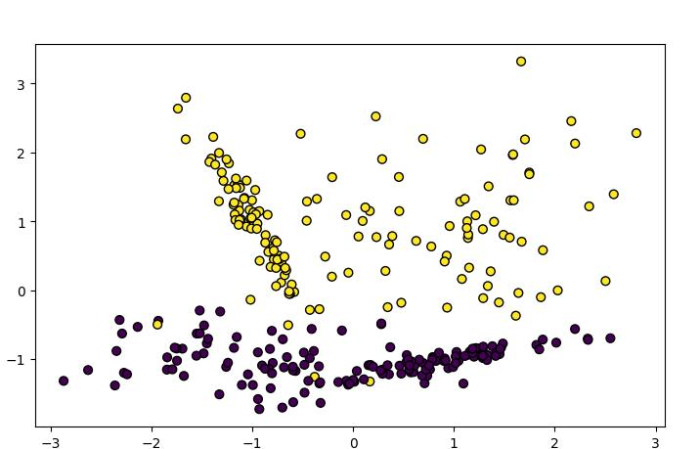
 Data Structure
Data Structure Networking
Networking RDBMS
RDBMS Operating System
Operating System Java
Java MS Excel
MS Excel iOS
iOS HTML
HTML CSS
CSS Android
Android Python
Python C Programming
C Programming C++
C++ C#
C# MongoDB
MongoDB MySQL
MySQL Javascript
Javascript PHP
PHP
- Selected Reading
- UPSC IAS Exams Notes
- Developer's Best Practices
- Questions and Answers
- Effective Resume Writing
- HR Interview Questions
- Computer Glossary
- Who is Who
How to build Naive Bayes classifiers using Python Scikit-learn?
Naïve Bayes classification, based on the Bayes theorem of probability, is the process of predicting the category from unknown data sets. Scikit-learn has three Naïve Bayes models namely,
- Gaussian Naïve Bayes
- Bernoulli Naïve Bayes
- Multinomial Naïve Bayes
In this tutorial, we will learn Gaussian Naïve Bayes and Bernoulli Naïve Bayes classifiers using Python Scikit-learn (Sklearn).
Gaussian Naïve Bayes Classifier
Gaussian naïve bayes classifier is based on a continuous distribution characterized by mean and variance.
With the help of an example, let's see how we can use the Scikit-Learn Python ML library to build a Gaussian Naïve Bayes classifier.
For this example, we will be using Gaussian Naïve Bayes model which assumes that the data for each label is drawn from a simple Gaussian distribution. The dataset we will be using is the Breast Cancer Wisconsin Diagnostic Database.
Example
# Importing the necessary packages import sklearn from sklearn.datasets import load_breast_cancer # Loading the dataset and organizing the data DataSet = load_breast_cancer() labelnames = DataSet['target_names'] labels = DataSet['target'] featurenames = DataSet['feature_names'] features = DataSet['data'] # Organizing dataset into training and testing set # by using train_test_split() function from sklearn.model_selection import train_test_split train, test, train_labels, test_labels = train_test_split(features,labels,test_size = 0.30, random_state = 300) # Model evaluation by using Naïve Bayes algorithm. from sklearn.naive_bayes import GaussianNB # Let's initializing the model: NBclassifier = GaussianNB() # Train the model: NBmodel = NBclassifier.fit(train, train_labels) # Making predictions by using pred() function: NBpreds = NBclassifier.predict(test) print("The predictions are:\n", NBpreds[:15]) # Finding accuracy of our Naive Bayes classifier: from sklearn.metrics import accuracy_score print("Accuracy of our classifier is:", accuracy_score(test_labels, NBpreds) *100)
Output
It will produce the following output ?
The predictions are: [0 0 1 1 0 0 0 1 1 1 1 1 0 1 0] Accuracy of our classifier is: 93.56725146198829
Bernoulli Naive Bayes Classifier
Bernoulli Naïve Bayes classifier is a binary algorithm. It is useful when we need to check whether a feature is present or not.
With the help of an example, let's see how we can use the Scikit-Learn Python ML library to build a Bernoulli Naïve Bayes classifier.
Example
In the below giving example, we will be using scikit-learn python library to implement Bernoulli Naïve Bayes algorithm on a dummy dataset.
from sklearn.datasets import make_classification # Importing libraries from sklearn.datasets import make_classification import matplotlib.pyplot as plt # Creating the classification dataset with one informative feature and one cluster per class nb_samples = 300 X, Y = make_classification(n_samples=nb_samples, n_features=2, n_informative=2, n_redundant=0) # Plotting the dataset plt.figure(figsize=(7.50, 3.50)) plt.subplots_adjust(bottom=0.05, top=0.9, left=0.05, right=0.95) plt.subplot(111) plt.scatter(X[:, 0], X[:, 1], marker="o", c=Y, s=40, edgecolor="k") plt.show()
Output
We will get the dummy dataset as follows ?

Example
Now, let's build Bernoulli Naïve bayes classifier on this dummy dataset ?
# Importing libraries from sklearn.datasets import make_classification import numpy as np # Model evaluation by using Bernoulli Naïve Bayes algorithm. # Import Bernoulli Naive bayes from sklearn from sklearn.naive_bayes import BernoulliNB # Organizing dataset into training and testing set # by using train_test_split() function from sklearn.model_selection import train_test_split # Creating the classification dataset with one informative feature and one cluster per class nb_samples = 300 X, Y = make_classification(n_samples=nb_samples, n_features=2, n_informative=2, n_redundant=0) X_train, X_test, Y_train, Y_test = train_test_split(X, Y, test_size=0.30) # Let's initializing the model B_NaiveBayes = BernoulliNB(binarize=0.0) # Train the model B_NaiveBayes.fit(X_train, Y_train) # Making predictions by using pred() function data = np.array([[0, 0], [0, 1], [1, 0], [1, 1]]) Preds=B_NaiveBayes.predict(data) print(Preds)
Output
It will produce the following output ?
array([0, 0, 1, 1])

